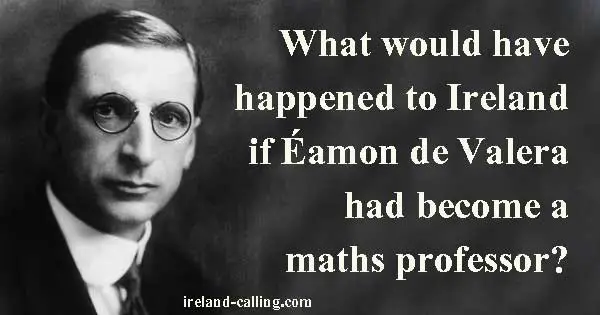Éamon de Valera is one of the key figures from Irish history.
He fought in the Easter Rising, and went on to hold the positions of Taoiseach and twice President of Ireland.
How different could the country’s history have been had de Valera been offered the job of mathematics professor at University College Cork in 1913?

Three years before the Easter Rising, de Valera applied for the academic role but was beaten to the post by Co Tyrone man Edgar Harper.
Had de Valera been selected, then who knows how his life path would have changed. It would certainly have had little effect on his beliefs in Irish independence, but could have kept his role in the fight more passive. For one he would have been living in Cork and not Dublin where the main nationalist movements were based.
De Valera saw things in black and white
De Valera was a mathematical thinker throughout his life. He saw things clearly in black and white, with no shades of grey in between.
This trait was possibly most visible in his opposition to the Anglo-Irish Treaty signed by Michael Collins and Arthur Griffiths in 1921.
Collins was not completely happy with the terms, but saw it as a stepping stone for the country. He said: “In my opinion it gives us freedom, not the ultimate freedom that all nations desire… but the freedom to achieve it.”
However, de Valera felt it conceded too much to the British government, and showed disrespect to the men that lost their lives fighting for an independent republic in the Rising.
This led to the split in the IRA with de Valera leading the anti-treaty faction into a civil war against their former comrades who were now the Irish Free State government led by Collins.
Des McHale is the current professor of maths at UCC. He supervised a PhD thesis by Kathleen O’Sullivan on the influence of mathematics in de Valera’s life. He said: “This mathematical aspect of his life is the one big blank in the life of de Valera that had not previously been filled in.
“The 1937 Constitution is just the type of document a mathematician might draw up. It’s entirely black-and-white, there are no shades of grey to it. Even in his very later years, when his sight was fading, he would still take mathematical books out of the library.”
Edgar Harper, the man who beat de Valera to the role of maths professor, later joined the British Army and died during the First World War.
De Valera never re-applied for the role and it was instead filled by Alfred O’Rahilly, who went on to become an adviser to the Sinn Féin negotiation team of Collins and Griffiths for the Anglo-Irish Treaty in 1921.
More history articles
The Neolithics – first people to leave their mark on Ireland